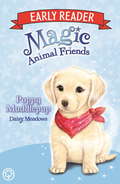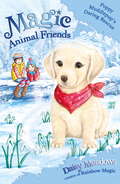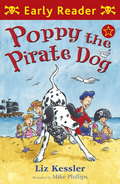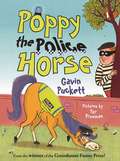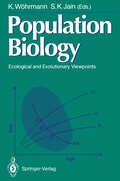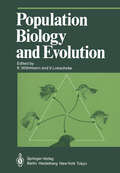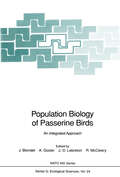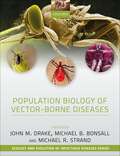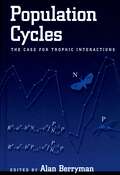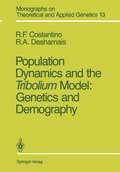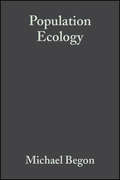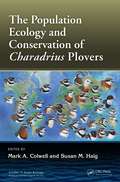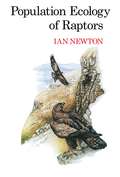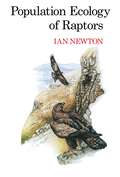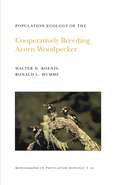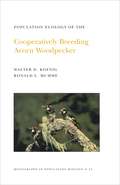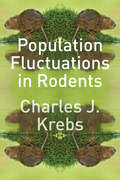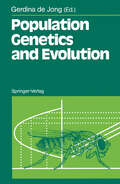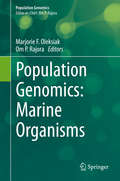- Table View
- List View
Poppy Muddlepup: Book 5 (Magic Animal Friends Early Reader #5)
by Daisy MeadowsThe much-loved series from the creator of Rainbow Magic - abridged for younger readers and illustrated in full colour!Welcome to a magical world where animals talk and play - just like you and me!Best friends Jess and Lily love all animals. But when they follow a mysterious golden cat into Friendship Forest - a place where animals live in tiny cottages and sip dandelion tea at the Toadstool Cafe - their animal friends suddenly become much more magical!Fluffy puppy Poppy Muddlepup needs help! Can the girls rescue Poppy's brother from Grizelda the witch?
Poppy Muddlepup's Daring Rescue: Special 1 (Magic Animal Friends #1)
by Daisy MeadowsWelcome to a magical world where animals talk and play - just like you and me!In this BUMPER SPECIAL, Lily and Jess meet Poppy Muddlepup. When the mean witch Grizelda puts a spell on Poppy's twin brother Patch, the girls know they're in for one of their most exciting adventures yet!
Poppy The Street Dog: How an extraordinary dog helped bring hope to the homeless
by Michelle ClarkA heartwarming true animal story, for fans of A Dog's Purpose, A Street Cat Named Bob and Marley & Me. Michelle Clark has loved animals all her life, filling her home with a menagerie of stray cats and abandoned dogs. But when her outreach work with London's homeless community leads to a chance meeting with a desperate man, and a quest to find a missing Staffie named Poppy, she has no idea that her life will be transformed forever.Poppy is unlike any other dog that Michelle has ever met, with her unwavering loyalty, gentle nature and wise, kind eyes. Soon, Poppy finds her way not just into Michelle's heart, but into her home too.Inspired Poppy's extraordinary love and devotion, Michelle finds herself at the start of a journey to bring hope and help to the hundreds of other precious dogs who call the city streets their home.An inspiring, heartwarming true story about the incredible bond that exists between humans and animals, and how, in rescuing them, we can also rescue ourselves.
Poppy the Pirate Dog: (early Reader) (Early Reader)
by Liz KesslerEarly Readers are stepping stones from picture books to reading books. A blue Early Reader is perfect for sharing and reading together. A red Early Reader is the next step on your reading journey.Poppy is very excited to be going on holiday, especially when she is given a skull and crossbones scarf to wear. But life as a pirate dog at the seaside is trickier than she realises...
Poppy the Pirate Dog's New Shipmate (Early Reader)
by Liz KesslerEarly Readers are stepping stones from picture books to reading books. A blue Early Reader is perfect for sharing and reading together. A red Early Reader is the next step on your reading journey.Poppy is not very happy to discover that she is getting a new shipmate - a kitten called George. She's sure he'll be stealing her pirate treasure, taking her favourite spot by the fire, and generally causing trouble. What's a pirate dog to do?
Poppy the Police Horse: Fables From The Stables Book 4 (Fables from the Stables)
by Gavin PuckettPoppy was fit, strong and healthy - her parent's delight.But for reasons unknown she was born without sight.But lucky for you lot, she had an amazing sense of smell. So she's recruited by the police force to solve the toughest crimes by nose . . .
Poppy’s Place in the Sun (A French Escape #1)
by Lorraine Wilson‘She had me at Bonjour! Warm, funny, deliciously French…this lovely story filled my heart with sunshine’ Jane Linfoot Sometimes you need to lose yourself to find your way home…
Population Biology: Ecological and Evolutionary Viewpoints
by K. Wöhrmann S. K. JainFascinated by the diversity of living organisms, humans have always been curious about its origin. Darwin was the first to provide the scholary and persuasive thesis for gradual evolution and speciation under natural selection. Although we now have much information on evolution, we still don't understand it in detail. Many questions still remain open due to the complexity and multiplicity of interacting factors. Several approaches mainly arising from population ecology and genetics are presented in this book in order to help understand genetic variation and evolution.
Population Biology and Evolution (Proceedings in Life Sciences)
by K. Wöhrmann V. LöschckeThis volume contains the papers presented at a symposium on popula tion biology sponsored by the Deutsche Forschungsgemeinschaft. It was . held at the guest house of the University of Ttibingen at Oberjoch on May 15-19, 1983. Prior to this conference a small group of European biologists had met in Berlin (June 1981) and Pavia (September 1982) to discuss re search problems on the borderline between population genetics and evolutionary ecology. From the contributions and discussions at these meetings it became evident that the unification of approaches to evolutionary problems in population genetics and evolutionary ecology has not yet been suc cessful and requires further efforts. It was the consensus that a larger symposium with international participation would be helpful to con front and discuss the different approaches to population biology in order to assess "where we are now" and "where we should be going. " As a result an organizational committee was formed (F. Christiansen, S. Jayakar, V. Loeschcke, W. Scharloo, and K. W6hrmann) to iden tify topics that seemed, at least to them, to be fruitful in tackling problems in population biology. Consequently, a number of colleagues were asked to participate in the meeting. We have divided this book into chapters corresponding to the eight topics chosen. The volume begins with the relation between genotype and phenotype and is followed by a chapter on quantitative genetics and selection in natural populations.
Population Biology of Passerine Birds: An Integrated Approach (Nato ASI Subseries G: #24)
by Jacques Blondel Andrew Gosler Jean-Dominique Lebreton Robin McCleeryPopulation Biology of Passerine Birds is an up-to-date synthesis of the most recent developments in its field, especially in the framework of modern life history theories. Major topics include quantitative genetics, ecological physiology, the study of social structures using individually marked birds in the wild, and finally biometry, which allows to quantify such important parameters as survival at different stages of life and to create a model of the overall demography of the populations.
Population Biology of Vector-Borne Diseases
Population Biology of Vector-Borne Diseases is the first comprehensive survey of this rapidly developing field. The chapter topics provide an up-to-date presentation of classical concepts, reviews of emerging trends, synthesis of existing knowledge, and a prospective agenda for future research. The contributions offer authoritative and international perspectives from leading thinkers in the field. The dynamics of vector-borne diseases are far more intrinsically ecological compared with their directly transmitted equivalents. The environmental dependence of ectotherm vectors means that vector-borne pathogens are acutely sensitive to changing environmental conditions. Although perennially important vector-borne diseases such as malaria and dengue have deeply informed our understanding of vector-borne diseases, recent emerging viruses such as West Nile virus, Chikungunya virus, and Zika virus have generated new scientific questions and practical problems. The study of vector-borne disease has been a particularly rich source of ecological questions, while ecological theory has provided the conceptual tools for thinking about their evolution, transmission, and spatial extent. Population Biology of Vector-Borne Diseases is an advanced textbook suitable for graduate level students taking courses in vector biology, population ecology, evolutionary ecology, disease ecology, medical entomology, viral ecology/evolution, and parasitology, as well as providing a key reference for researchers across these fields.
Population Cycles: The Case for Trophic Interactions
by Alan BerrymanFor over sixty years, understanding the causes of multiannual cycles in animal populations has been a central issue in ecology. This book brings together ten of the leaders in this field to examine the major hypotheses and recent evidence in the field, and to establish that trophic interactions are an important factor in driving at least some of the major regular oscillations in animal populations that have long puzzled ecologists.
Population Dynamics and the Tribolium Model: Genetics and Demography (Monographs on Theoretical and Applied Genetics #13)
by Robert F. Costantino Robert A. DesharnaisThe study of populations is becoming increasingly focused on dynamics. We believe there are two reasons for this trend. The ftrst is the impactof nonlinear dynamics with its exciting ideas and colorful language: bifurcations, domains of attraction, chaos, fractals, strange attractors. Complexity, which is so very much a part of biology, now seems to be also a part of mathematics. A second trend is the accessibility of the new concepts. Thebarriers tocommunicationbetween theoristandexperimentalistseemless impenetrable. The active participationofthe experimentalist means that the theory will obtain substance. Our role is the application of the theory of dynamics to the analysis ofbiological populations. We began our work early in 1979 by writing an ordinary differential equation for the rateofchange in adult numbers which was based on an equilibrium model proposed adecadeearlier. Duringthenextfewmonths weftlledournotebookswithstraightforward deductions from the model and its associated biological implications. Slowly, some of the biological observations were explained and papers followed on a variety of topics: genetic and demographic stability, stationary probability distributions for population size,population growth asabirth-deathprocess, natural selectionanddensity-dependent population growth, genetic disequilibrium, and the stationary stochastic dynamics of adult numbers.
Population Ecology: A Unified Study of Animals and Plants
by Michael Begon Martin Mortimer David J. ThompsonWorldwide, Population Ecology is the leading textbook on this titled subject. Written primarily for students, it describes the present state of population ecology in terms that can be readily understood by undergraduates with little or no background in the subject. Carefully chosen experimental examples illustrate each topic, and studies of plants and animals are combined to show how fundamental principles can be derived that apply to both species. Use of complex mathematics ia avoided throughout the book, and what math is necessary is dealt with by examination of real experimental data rather than dull theory. The latest edition of this leading textbook. Adopted as an Open University set text.
The Population Ecology and Conservation of Charadrius Plovers (Studies in Avian Biology #53)
by Mark A. Colwell Susan M. HaigThe 40 or so species of beach-loving plovers (genus Charadrius) comprise a diverse group of shorebirds found around the world. Most of these species are challenged by changing climates and other human-related development activities, yet they provide key insights into basic ecological and evolutionary processes. The expert international contributors take a comparative approach, presenting examples from many worldwide plover studies and synthesizing the group’s most pressing and important topics. The book further presents an emphasis on full life-cycle biology, including the importance of examining migratory connectivity issues, even for non-migratory plovers. Key Features Serves as a fundamental resource for conservation practitioners Detailed overview of a widely distributed group of shorebirds Authored by renowned specialists who present theoretical and applied perspectives Emphasis on comparative and synthetic approach in all chapters Related Titles McComb, B. et al. Monitoring Animal Populations and Their Habitats: A Practitioner’s Guide (ISBN 978-0-4291-3827-0). Garvey, J. E. & M. R. Whiles. Trophic Ecology (ISBN 978-1-4987-5846-8). Dewdney, A. K. Stochastic Communities: A Mathematical Theory of Biodiversity (ISBN 978-1-1381-9702-2).
Population Ecology of Raptors (Poyser Monographs)
by Ian NewtonDr Newton's book is concerned with all aspects of population regulation in diurnal birds of prey, their social behaviour, dispersion, numbers, movements, breeding and mortality. He has drawn on his own studies in Scotland and on material and investigations worldwide to produce an authoritative and stimulating synthesis of current thinking and research on the ecological problems of the Falconiformes. He also deals in detail with the effects of pesticides and other pollutants on these birds, and with their scientific management and conservation. The author's lucid style will ensure a wide readership among research workers and the more general audience with an interest in birds of prey. There is a full bibliography and an extensive appendix of tables.
Population Ecology of Raptors (Poyser Monographs #113)
by Ian NewtonDr Newton's book is concerned with all aspects of population regulation in diurnal birds of prey, their social behaviour, dispersion, numbers, movements, breeding and mortality. He has drawn on his own studies in Scotland and on material and investigations worldwide to produce an authoritative and stimulating synthesis of current thinking and research on the ecological problems of the Falconiformes. He also deals in detail with the effects of pesticides and other pollutants on these birds, and with their scientific management and conservation. The author's lucid style will ensure a wide readership among research workers and the more general audience with an interest in birds of prey. There is a full bibliography and an extensive appendix of tables.
Population Ecology of the Cooperatively Breeding Acorn Woodpecker. (MPB-24), Volume 24
by Walter D. Koenig Ronald L. MummeEver since the acorn woodpecker was observed and described by Spanish explorers, its behavior--particularly the unique habit of caching acorns in specialized storage trees or granaries--has impressed observers. Acorn woodpeckers are also one of the few temperate zone species in which young are reared communally in family groups. This demographic study investigates the complexities of acorn storage and group living in acorn woodpeckers at Hastings Reservation in central coastal California. It is one of the most thorough studies of any avian social system to date.
Population Ecology of the Cooperatively Breeding Acorn Woodpecker. (Monographs in Population Biology #104)
by Walter D. Koenig Ronald L. MummeEver since the acorn woodpecker was observed and described by Spanish explorers, its behavior--particularly the unique habit of caching acorns in specialized storage trees or granaries--has impressed observers. Acorn woodpeckers are also one of the few temperate zone species in which young are reared communally in family groups. This demographic study investigates the complexities of acorn storage and group living in acorn woodpeckers at Hastings Reservation in central coastal California. It is one of the most thorough studies of any avian social system to date.
Population Fluctuations in Rodents
by Charles J. KrebsHow did rodent outbreaks in Germany help to end World War I? What caused the destructive outbreak of rodents in Oregon and California in the late 1950s, the large population outbreak of lemmings in Scandinavia in 2010, and the great abundance of field mice in Scotland in the spring of 2011? Population fluctuations, or outbreaks, of rodents constitute one of the classic problems of animal ecology, and in Population Fluctuations in Rodents, Charles J. Krebs sifts through the last eighty years of research to draw out exactly what we know about rodent outbreaks and what should be the agenda for future research. Krebs has synthesized the research in this area, focusing mainly on the voles and lemmings of the Northern Hemisphere—his primary area of expertise—but also referring to the literature on rats and mice. He covers the patterns of changes in reproduction and mortality and the mechanisms that cause these changes—including predation, disease, food shortage, and social behavior—and discusses how landscapes can affect population changes, methodically presenting the hypotheses related to each topic before determining whether or not the data supports them. He ends on an expansive note, by turning his gaze outward and discussing how the research on rodent populations can apply to other terrestrial mammals. Geared toward advanced undergraduate students, graduate students, and practicing ecologists interested in rodent population studies, this book will also appeal to researchers seeking to manage rodent populations and to understand outbreaks in both natural and urban settings—or, conversely, to protect endangered species.
Population Fluctuations in Rodents
by Charles J. KrebsHow did rodent outbreaks in Germany help to end World War I? What caused the destructive outbreak of rodents in Oregon and California in the late 1950s, the large population outbreak of lemmings in Scandinavia in 2010, and the great abundance of field mice in Scotland in the spring of 2011? Population fluctuations, or outbreaks, of rodents constitute one of the classic problems of animal ecology, and in Population Fluctuations in Rodents, Charles J. Krebs sifts through the last eighty years of research to draw out exactly what we know about rodent outbreaks and what should be the agenda for future research. Krebs has synthesized the research in this area, focusing mainly on the voles and lemmings of the Northern Hemisphere—his primary area of expertise—but also referring to the literature on rats and mice. He covers the patterns of changes in reproduction and mortality and the mechanisms that cause these changes—including predation, disease, food shortage, and social behavior—and discusses how landscapes can affect population changes, methodically presenting the hypotheses related to each topic before determining whether or not the data supports them. He ends on an expansive note, by turning his gaze outward and discussing how the research on rodent populations can apply to other terrestrial mammals. Geared toward advanced undergraduate students, graduate students, and practicing ecologists interested in rodent population studies, this book will also appeal to researchers seeking to manage rodent populations and to understand outbreaks in both natural and urban settings—or, conversely, to protect endangered species.
Population Fluctuations in Rodents
by Charles J. KrebsHow did rodent outbreaks in Germany help to end World War I? What caused the destructive outbreak of rodents in Oregon and California in the late 1950s, the large population outbreak of lemmings in Scandinavia in 2010, and the great abundance of field mice in Scotland in the spring of 2011? Population fluctuations, or outbreaks, of rodents constitute one of the classic problems of animal ecology, and in Population Fluctuations in Rodents, Charles J. Krebs sifts through the last eighty years of research to draw out exactly what we know about rodent outbreaks and what should be the agenda for future research. Krebs has synthesized the research in this area, focusing mainly on the voles and lemmings of the Northern Hemisphere—his primary area of expertise—but also referring to the literature on rats and mice. He covers the patterns of changes in reproduction and mortality and the mechanisms that cause these changes—including predation, disease, food shortage, and social behavior—and discusses how landscapes can affect population changes, methodically presenting the hypotheses related to each topic before determining whether or not the data supports them. He ends on an expansive note, by turning his gaze outward and discussing how the research on rodent populations can apply to other terrestrial mammals. Geared toward advanced undergraduate students, graduate students, and practicing ecologists interested in rodent population studies, this book will also appeal to researchers seeking to manage rodent populations and to understand outbreaks in both natural and urban settings—or, conversely, to protect endangered species.
Population Fluctuations in Rodents
by Charles J. KrebsHow did rodent outbreaks in Germany help to end World War I? What caused the destructive outbreak of rodents in Oregon and California in the late 1950s, the large population outbreak of lemmings in Scandinavia in 2010, and the great abundance of field mice in Scotland in the spring of 2011? Population fluctuations, or outbreaks, of rodents constitute one of the classic problems of animal ecology, and in Population Fluctuations in Rodents, Charles J. Krebs sifts through the last eighty years of research to draw out exactly what we know about rodent outbreaks and what should be the agenda for future research. Krebs has synthesized the research in this area, focusing mainly on the voles and lemmings of the Northern Hemisphere—his primary area of expertise—but also referring to the literature on rats and mice. He covers the patterns of changes in reproduction and mortality and the mechanisms that cause these changes—including predation, disease, food shortage, and social behavior—and discusses how landscapes can affect population changes, methodically presenting the hypotheses related to each topic before determining whether or not the data supports them. He ends on an expansive note, by turning his gaze outward and discussing how the research on rodent populations can apply to other terrestrial mammals. Geared toward advanced undergraduate students, graduate students, and practicing ecologists interested in rodent population studies, this book will also appeal to researchers seeking to manage rodent populations and to understand outbreaks in both natural and urban settings—or, conversely, to protect endangered species.
Population Genetics and Evolution
by Bas TeunissenAt least since the 1940s neo-Darwinism has prevailed as the consensus view in the study of evolution. The mechanism of evolution in this view is natural selection leading to adaptation, working on a substrate of adapta tionally random mutations. As both the study of genetic variation in natural populations, and the study of the mathematical equations of selec tion are reckoned to a field called population genetics, population genetics came to form the core in the theory of evolution. So much so, that the fact that there is more to the theory of evolution than population genetics became somewhat obscured. The genetics of the evolutionary process, or the genetics of evolutionary change, came close to being all of evolutionary biology. In the last 10 years, this dominating position of population genetics within evolutionary biology has been challenged. In evolutionary ecology, optimization theory proved more useful than population genetics for interesting predictions, especially of life history strategies. From develop mental biology, constraints in development and the role of internal regula tion were emphasized. From paleobiology, a proposal was put forward to describe the fossil record and the evolutionary process as a series of punc tuated equilibria; thus exhorting population geneticists to give a plausible account of how such might come about. All these developments tend to obscure the central role of population genetics in evolutionary biology.
Population Genomics: Marine Organisms (Population Genomics)
by Marjorie F. Oleksiak Om P. RajoraPopulation genomics has provided unprecedented opportunities to unravel the mysteries of marine organisms in the oceans' depths. The world's oceans, which make up 70% of our planet, encompass diverse habitats and host numerous unexplored populations and species. Population genomics studies of marine organisms are rapidly emerging and have the potential to transform our understanding of marine populations, species, and ecosystems, providing insights into how these organisms are evolving and how they respond to different stimuli and environments. This knowledge is critical for understanding the fundamental aspects of marine life, how marine organisms will respond to environmental changes, and how we can better protect and preserve marine biodiversity and resources. This book brings together leading experts in the field to address critical aspects of fundamental and applied research in marine species and share their research and insights crucial for understanding marine ecosystem diversity and function. It also discusses the challenges, opportunities and future perspectives of marine population genomics.
